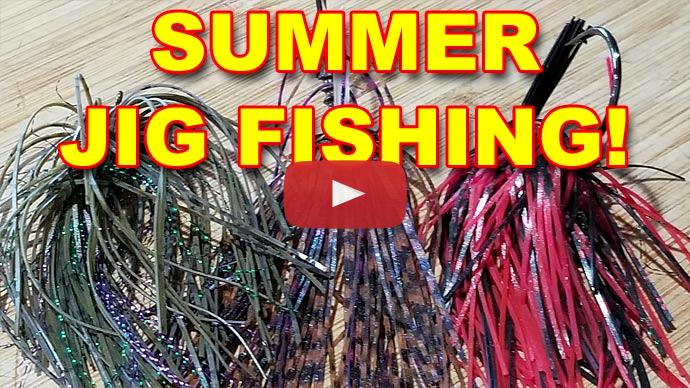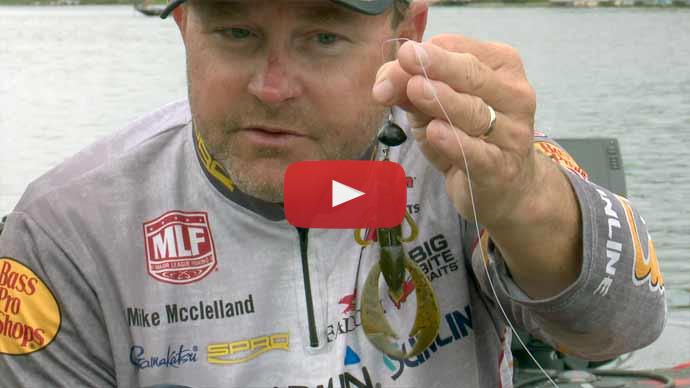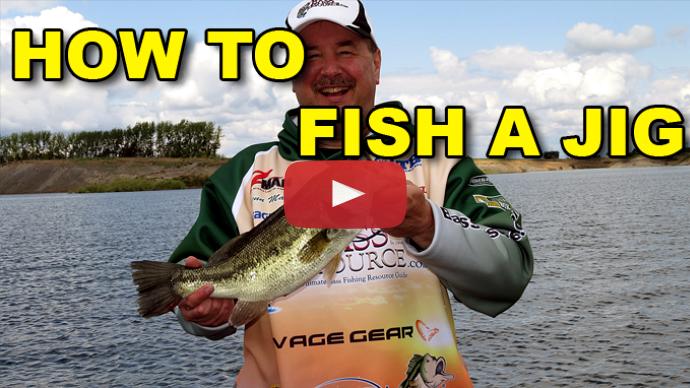Hey, everyone, Mike McClelland here to talk summertime jig fishing with BassResource. And, you know, I tell you what, I absolutely love to have a jig tied on. I mean, if I could go to any tournament anywhere across the country and catch them on a jig, I would be 100% satisfied. I mean, I've won a ton of money on a jig, and it's my confidence bait. It's that bait that, if I'm struggling, I'm going to pick a jig up and go figure out how to catch some bass on a jig.
When you talk summertime jig fishing, I mean, we're going to kind of take this as, you know, from the time the fish get done spawning, you know, through that shad spawn period, through the bream spawn period, up into, you know, when the fish really start getting into their summertime patterns, that post-spawn to summertime patterns. And there's just so many different things that play.
So let's just kind of take it as a breakdown, you know, leading up from that period that the fish typically get done spawning. That is that time of year that there's a lot of ways that you can take advantage of catching bass on a jig. I mean, you have to realize fish are going to be guarding fry. Fish are going to be starting to feed back up. Fish are going to be, you know, trying to protect beds even from bream and things like that. So a jig is definitely one of those baits that comes into play.
You know, when it comes to those situations where you know you're fishing a body water where the fish are guarding fry, they're guarding beds, things like that, a swim jig is just a jig that you've got to have in your arsenal. I mean, typically, if I'm throwing a swim jig that time of year, I want to be throwing around the spawn. It's typically going to be a bream-colored bait, you know, black and blue, black and purple, you know, something green pumpkin, green pumpkin, orange, things that are going to mimic bream and things of that nature that are predators to a bass when they're spawning.
Generally, when I'm throwing a swim jig that time of year, especially if I'm fishing in heavy vegetation, you know, Florida lakes, grass lakes, things like that, I'm always going to throw my swim jigs on either 30 or 50-pound Sunline, either Sunline FX2 or Asegai Braid, generally always 30 to 50 pounds.
I like when I'm throwing a swim jig, I soften the action of my rod up a little bit. I typically am going to throw a 5173 Falcon Cara. The rod's got a lot of tips, so, you know, when you're throwing braided line, it's really important to have a rod that flexes to those fish. But, typically, what you're looking for is those areas where fish are going to spawn or where they're going to be guarding fry. You're typically trying to cover a lot of water, matching the hatch, you know, on bream.
A lot of times, the further south you go, you have a lot of those really tannic type waters. That typically is where black and blue, in my opinion, works better. But when you get in those situations where you're fishing lakes that are a little bit cleaner or just a normal watercolor, that's when, you know, just more typical bream-type colors, you know, green pumpkin, green pumpkin, orange, things like that.
Generally, trailers can make a big, big difference when you're swimming a jig. A Big Bite Fighting Frog is one of my favorite trailers, day in, day out, when I'm swimming a jig. But you want to keep in mind that there's a lot of other trailers that, you know, might work a little bit better. The Big Bite Swimon, either in the 4.25 or the 3.75, is a really good trailer for a swim jig. Those are kind of my swim jig rules of thumb.
When it comes to getting past that spawning period and you get into that area where almost every lake across the country, about the time that bass get done spawning, you typically have a shad spawn. And that is when you can really make hay with a shad-colored swim jig. You know, something in a white, a white and silver, you know, white and chartreuse, white and blue, so many different variations. But a white swim jig becomes a real, real key player for me when you get into that shad spawn period, especially in lakes that have a lot of boat docks, have a little bit of color in the water, and especially lakes that have a lot of vegetation.
Pretty much the same deal, you know, I'm going to be throwing a braided line around a lot of those situations. Unless I'm fishing around, you know, boat docks, isolated cover, things like that, I'll go to a 16 to 20-pound Sunline Shooter getting into the summertime period. You know, early, early spring, I like Sniper, but when I get into that summertime period, I definitely like to go to Sunline Shooter across the board. And it's typically always going to be 16 to 20-pound test. Occasionally, you got to kick it up to 22 when you get around a lot of heavy cover situations.
Another thing in the spring, you know, swim jig fishing is one thing I love to do, but day in, day out, and you're going to see me with this jig tied on almost 12 months of the year. I'm always going to have a little 1/2-ounce, hand-tied, brown, round rubber jig. And I'm going to vary my trailers on that jig all through the course of the year.
You know, getting into that springtime period, you've got a lot of fish that will set up on isolated targets, guarding fry, things of that nature, fish that just set up around boat docks and start feeding. And this is just one of those little jigs that any isolated type cover, boat docks, things like that, just fishing, you know, little channel swings and things like that, this is a jig that I'm always going to reach to when I need to generate a bite. You can see I've got a Big Bite Kamikaze Craw on it. As the water temperature warms up and you get into that springtime period, I feel like actions in your trailers become a little bit more critical. And I like a trailer that's got a lot more flapping action when you get into that summertime period. So you definitely want to keep that in mind.
Then as you progress a little bit further, and those fish, you know, start getting done spawning, the shad spawn has ended, and you're getting into that summertime period of the year, that is when, you know, football season, in my opinion, starts. And when I say football season, I'm talking football jig fishing. And, you know, this bait right here has won a ton of money for me. You know, a football jig and a 5/8 to a 3/4-ounce, occasionally a 1/2-ounce, depending on the style of lake and things that you're fishing, become really critical. But, you know, rate of fall, again, is key.
But, typically, when I'm looking for fish in that post-spawn period, in the summertime period, with a football jig, I'm going to start on secondary points. It's almost like a reverse of what happens in the spring. Wherever those fish stage, they're going to start migrating back to when they get done spawning, they start grouping up. So secondary points out to main lake points, things like that. And, really, it's all about finding a depth. You know, once you determine where the majority of the bait is set up or where the thermocline in a particular body of water is starting to set up, you can pretty much call your shots once you figure that out. But the beauty of a football jig is you can do so many different things with it.
I mean, you can see here I've got a Big Bite Battle Bug as a trailer. I typically like to really bulk up the size of my bait. I mean, after the spawn, those fish are...they're wanting to feed back up. A lot of times a bigger bait will generate, not just bigger bites, but it'll generate more bites because the fish doesn't want to waste a ton of energy, you know, feeding on a bunch of little stuff. They want a big morsel, and a 5/8 or a 3/4-ounce football jig with a Big Bite Battle Bug in a variety of different colors can really come into play.
Generally, when I'm fishing a football jig, whether it be, you know, anything from a 3/8-ounce all the way up to a 3/4, I'm always doing it with my 6174 Falcon Cara. And, again, line size is going to depend on the type of water clarity that I'm fishing. It's also going to depend on the type of cover I'm fishing. If I can get away with throwing 16, I'll throw 16 a lot, but I would much rather be able to beef it up 18, 20, 22 when I get in those right scenarios and situations.
Summertime jig fishing is one of those deals that I travel all over the country, and there's very few lakes. I mean, some of those, you know, gin-clear, you know, rocky clear, clear clear lakes, a jig doesn't play as often unless you get the right conditions, but anytime you've got a little bit of color in the water, just a slight tint, you got fish that are feeding on crawfish, bream, things like that, you gotta pick a jig up, and you're gonna catch more fish this summer.



